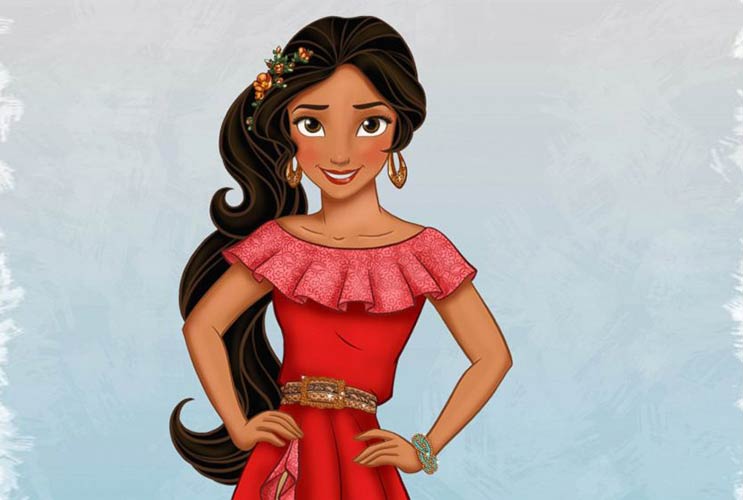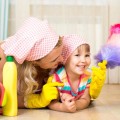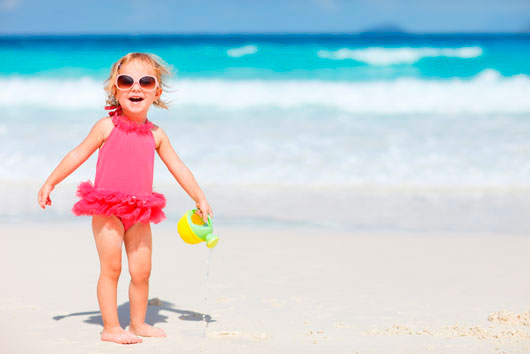
1. SUNBURN
How bad can a sunburn get? Let us count the ways. Sunburns can cause intense pain, damage to the skin and eyes, skin cancer, and even problems with their immune systems.
Prevention & Treatment: Prevention is the best cure for sun-related ails. First off, be aware that the sun is at its strongest, “usually 10 a.m. until 4 p.m. in the northern hemisphere,” according to KidsHealth. Hang out in the shade when possible, and when weather permits, dress your child in loose-fitting, long-sleeved shirts and pants, along with a hat that shields the head and face from the sun. But let’s face it—there’s going to be plenty of sunshine, rompers, and bathing suits this summer, so it’s important to pick the right sunscreen and apply it often. Problem is, not all kids’ sunscreens are created equally; some contain undesirable elements like the potentially skin-irritating component paraben or Vitamin A, a.k.a. retinyl palmitate, which “speeds the development of skin tumors and lesions when applied to the skin in the presence of sunlight,” according to the Environmental Working Group. We love the products by TruKid, like their SPORT TruKid Sunny Days SPF30+ Unscented Water Resistant Lotion ($18.99) and their Face Stick ($9.99) which makes sunblock application easy on wiggling kids. TruKid also has a line of baby products; although parents used to be cautioned against putting sunscreen on babies younger than six months (and it is still suggested that clothes, hats, and stroller canopies be used as protection against the sun’s rays) the American Academy of Pediatrics has recently revised this warning, now suggesting that with babies under six months, “sunscreen on small areas of the body, such as the face and the backs of the hands” can be used “if protective clothing and shade are not available.” To be extra safe, do a “patch test” the night before using sunblock on Baby for the first time, with a tiny amount of sunblock applied to Baby’s skin (to protect against potential skin irritation or allergic reaction).
Read Related: Help Kids Play It Safe in Summer
2. DEHYDRATION
Hot weather brings with it a ton of playtime, exercise, and sweating—and the potential for dehydration. And looking to your child to see if he or she is thirsty is not a reliable barometer. “By the time a child feels thirsty, he or she may already be dehydrated,” reports KidsHealth.
Prevention & Treatment: During the hot weather or while partaking in rigorous activities (or both), make sure your kids drink regularly (every 20 to 30 minutes). A water canteen can help facilitate hydration, and is safer and more environmentally friendly than water bottles. Crocodile Creek makes a colorful, stainless-steel canteen that is BPA-free and phthalate-free Crocodile Creek Kids Drinking Bottle ($8.53). And as with any summer ailment, know the signs and symptoms. A dehydrated child can have sunken eyes, dry diapers, and crying without tears (familiarize yourself with the list of symptoms on KidsHealth). Dehydration can be dangerous, so if you think your child is dehydrated, begin trying to rehydrate them and contact your pediatrician immediately.
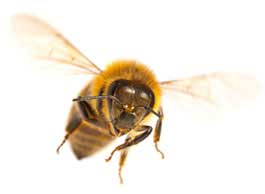 3. BEE STINGS
3. BEE STINGS
Besides being scary and painful, bee stings carry with them a fatal potential, that of anaphylaxis, a possibly deadly allergic reaction. If you’re concerned about your child having an allergic reaction to a bee (or other insect bite), such as a history of allergies, asthma, or a previous allergic reaction, discuss it with your pediatrician. And know the signs of a severe allergic reaction; check out the American Academy of Allergy Asthma and Immunology (AAAAI)’s website for a list of symptoms.
Prevention & Treatment: Last summer during a weekend away in upstate New York, my partner Joe and his six-year-old son, Ruari, were looking for the perfect marshmallow-roasting stick in the woods when they inadvertently stumbled upon a hive of wasps. They were swarmed, and between the two of them, they came away with over thirty stings. Caution your children to stay on paths when exploring wooded areas, and warn them that when provoked, many bees and wasps will sting. Let them know that, according to WebMD, “Yellow jackets nest in the ground in dirt mounds or old logs and walls. Honeybees nest in beehives. Hornets and wasps nest in bushes, trees, and on buildings.” And warn your kids that while they love to prod and poke things like a roly-poly caterpillar or an earthworm, bees or wasps may feel attacked and return the favor. If your child does get stung, they may be understandably panicked, so pack on the TLC along with common sense. First off, if the bee has left a stinger, remove it, otherwise it can continue to release its venom. “Gently scrape the sac and stinger out with a fingernail or a stiff-edged object like a credit card,” according to WebMD. “Do not squeeze the sac or pull on the stinger—this will cause the release of more venom into the skin.” A home remedy that worked wonders with my stepson Ruari was a paste made of baking soda and water applied directly to the stings, as well as lots of TLC and distraction from the stings, too (for Ruari, this came in the form of his Nintendo DS).
4. TICKS
They may be tiny, but ticks can pack a very dangerous punch in the form of infections like Lyme disease.
Prevention & Treatment: Ticks will latch onto their unsuspecting victims as they traipse through wooded areas with high grass, bushes, and the like. Do you best to have your child cover up whenever possible, including their ankles (try having them wear shoes and socks during excursions, such as hiking, and tuck their socks into their pant legs). A (safe) bug repellant won’t hurt either. In addition, a full-body tick check will be in order at the end of any day spent hiking or exploring. The Centers for Disease Control and Prevention advises “a full-body tick check using a hand-held or full-length mirror to view all parts of your body upon return from tick-infested areas. Parents should check their children for ticks under the arms, in and around the ears, inside the belly button, behind the knees, between the legs, around the waist, and especially in their hair.” (If you have outdoor pets, don’t leave them out when you do your tick-check, as they can bring ticks into your home.) And if you find one of the dangerous little buggers? Simply remove it with tweezers; the CDC provides a full set of instructions on their website, but basically the aim is to carefully and steadily remove the entire tick from the skin (this may take several tries if the tick’s body breaks); make sure to wash the area afterwards. If you suspect your child has a tick bite, contact your pediatrician immediately; you may be able to identify it by the classic “bulls eye” rash that can accompany a bite, but familiarize yourself with the appearance of bites, as they can be varied (WebMD has a whole gallery).
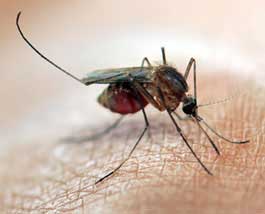 5. MOSQUITO BITES
5. MOSQUITO BITES
We all know that they itch (boy, do they itch!) but mosquito bites can also carry disease and cause allergic reactions. What’s more, the repellents used to keep them at bay can contain toxic chemicals like DEET.
Prevention & Treatment: Mosquitoes tend to be at their most troublesome at dawn or as evening falls, although they certainly seem to be all-day snackers. Try a natural bug repellant like the DEET-free California Baby® Natural Bug Blend™ Bug Repellent ($13.49) which uses the scents of Citronella, lemongrass and cedar essential oils to repel bugs. Loose-fitting, long-sleeved shirts and pants can keep them from nipping at your child’s arms and ankles when the weather isn’t too hot to allow for that kind of coverage. Familiarize yourself with the symptoms of an allergic reaction (which can include swelling in the throat and difficulty breathing) and infections caused by disease-bearing mosquitoes (signs can include fever, vomiting, and swollen glands); check the Mayo Clinic’s list of signs and symptoms. For plain old itchies, try a topical cream like Aveeno Anti-Itch Cream ($19.49 for a pack of 6), which contains soothing Colloidal Oatmeal.
6. POISON IVY
Speaking of itching, mosquitoes haven’t got the market cornered on this aggravating affliction. Fortunately, although poison ivy can cause a rash and serious itching, it’s “generally not serious,” according to the Mayo Clinic (check out the Mayo Clinic’s list of symptoms, however, for when to call a doctor).
Prevention & Treatment: “Leaves of three, let it be,” was the little poem my camp counselors told me to remember as a child when traversing wooded areas with lots of leafy green plants. The problem was, I saw a great deal of plant life with three leaves, most of which were not poison ivy. (And I somehow made contact anyway.) If you’re going to be out camping or tramping through the woods on a family hiking trip, it’s good to stick to paths (if there are paths), wear clothing that covers you up, and know what poison ivy looks like. It’s here that the Internet really comes in handy, with sites like Poisonivy.aesir.com, which provides galleries of photos, not just of poison ivy, but of poison oak and poison sumac, two other similar irritants. Familiarize yourself with the look of these offenders, but if you fall prey to their itchy attacks anyway, make sure to wash the area with soap and water, and have a remedy ready. There are over-the-counter anti-itch creams you can purchase as you would for mosquito bites, and Discovery Health offers a list of home remedies like vinegar, aloe vera, and even iced coffee.
7. OUCHIES
Skinned knees and elbows, beat-up feet—these may be the summer ailment for which there is no is no real prevention. Of course, with any active kid, boo-boos are a year-long hazard, but something about the warm weather—limbs exposed by t-shirts and shorts, the impulse to go barefoot, and surfaces made slick by pool or sprinkler water—makes children all the more vulnerable to a variety of cuts and scrapes.
Prevention & Treatment: For ouchie feet, invest in a pair of water-friendly shoes. Flip-flops will flip-flop right off your child’s feet, so go with a pair that’s snug-fitting like Boys Brandt Beach Socks ($7.99) that have an adjustable fit and an affordable price tag, or a pair sporting a strap like Crocs™ Keeley Mary Jane Flat ($24.99). When it comes to skinned knees and elbows, they’re pretty much inevitable with an active child; being prepared can make that potentially agonizing, stiff-legged or stiff-armed walk back home a bit easier. Tote along a boo-boo kit to outdoor excursions, like the adorable I’m OK! Mini First Aid Set ($14), which comes in a variety of designs like Pink Princess or Orange Bear and contains band-aids, antiseptic swabs, and a cold pack.







